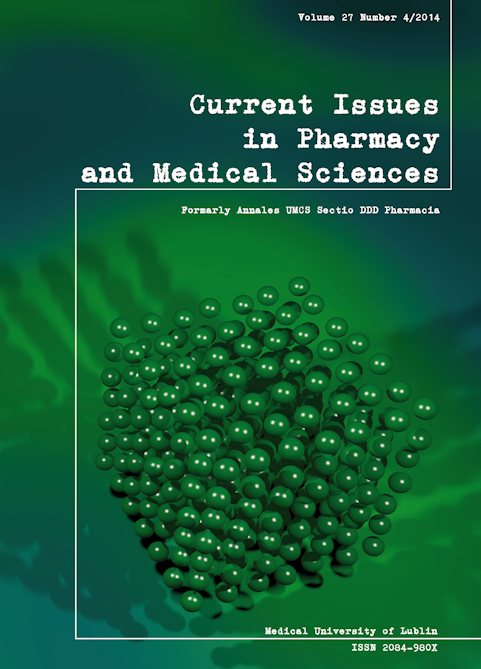Cytotoxic activity of ethanolic extracts of Eleutherococcus species cultivated in Poland on HL60 leukemia cell line
DOI:
https://doi.org/10.2478/cipms-2014-0011Słowa kluczowe:
eleutherosides, cytotoxicity, apoptosis, Eleutherococcus, HL60Abstrakt
The Eleutherococcus species including 40 species native to Asia are medicinal plants widely used in traditional medicine. Some of these species are cultivated at the botanical gardens in Europe. On the basis on our earlier studies it was concluded that the extracts of analyzed species act as antioxidants, inhibitors of MMPs, and cytotoxic against Jurkat 45 leukemia cell line. In this study, the anti-leukemic potential of roots and leaves from six Eleutherococcus species cultivated in Poland was determined.
The in vitro cytotoxic activity towards human promyelotic leukemia cell line HL60 using trypan blue assay was evaluated. The induction of apoptosis in stimulated leukemia cells was determined by AnnexinV method. Morphological changes in treated cells were observed by microscopic investigations.
The results showed that ethanolic extracts from the roots and the leaves of E. senticosus, E. setchuensis, E. sessiliflorus, E.gracilistylus, E. henryi and E. divaricatus exhibit cytotoxic effect towards leukemic HL60 cells. The received IC50 values for roots ranged from 49-208 µg/mL and for the leaves from 116-518 µg/mL. The ethanol extract from the roots of E. divaricatus showed the highest cytotoxic and proapoptotic effect on HL60 human lymphoid leukemia cell line.
Bibliografia
1. Cieśla Ł. et al.: HPTLC – densitometric method for determination of eleutherosides B, E and E1 in different Eleutherococcus species. J. Chromatog. Sci., 49 (3), 182-186, 2011.
2. Feng S., Hu F., Zhao J.: Determination of eleutheroside E and eleutheroside B in rat plasma and tissue by high-performance liquid chromatography using solid-phase extraction and photodiode array detection. Eur. J. Pharm. Biopharm. 62, 315-320, 2006.
3. Ha E.S. et al.: Anti-metastatic activity of glycoprotein fractionated from Acanthopanax senticosus, involvement of NK-cell and macro¬phage activation. Arch. Pharm. Res. 27(2), 217-224, 2004.
4. Hacker B., Medon P.J.: Cytotoxic effects of Eleutherococcus sentico¬sus aqueous extracts in combination with N6-(delta 2-isopentenyl)¬-adenosine and 1-beta-D-arabinofuranosylcytosine against L1210 leukemia cells. J. Pharm. Sci. 73(2), 270-272, 1984.
5. Hibasami H. et al.: Induction of apoptosis by Acanthopanax senticosus Harms and its component, sesamin in human stomach cancer KATO III cells. Oncol. Rep. 7, 1213-1216, 2000.
6. Chon S.U. et al.: Total phenolics level, antioxidant activities and cyto¬toxicity of young sprouts of some Traditional Korean Salad Plants. Plant. Foods Hum. Nutr., 64, 25–31, 2009.
7. Jang M.H. et al.: Protective effect of Acanthopanax senticosus against ethanol-induced apoptosis of human neuroblastoma cell line SK-N-MC. Am. J. Chin. Med. 31, 379-388, 2003.
8. Kurkin V.A. et al.: Antidepressant activity of some phytopharmaceu¬ticals and phenylpropanoids. Pharm.Chem. J. 40 (11), 614-619, 2006.
9. Li Z.F. et al.: Two diketopiperazines from Acanthopanax senticosus Harms. J. Asian Nat. Prod. Res. 12, 51–55, 2010.
10. Liu W. (2011). Traditional herbal medicine research methods. New Jersey:John Wiley&Sons.
11. Panossian A.: Stimulating effect of adaptogens: An overview with particular reference to their efficacy following single dose adminis¬tration. Phytother. Res. 19(10), 819-838, 2005.
12. Shan B.E. et al.: Chinese medicinal herb, Acanthopanax gracilisty¬lus, extract induces cell cycle arrest of human tumor cells in vitro. Clin. Exp. Immunol. 118, 41-8, 1999.
13. Sun Y.L., Liu L.D., Hong S.K.: Eleutherococcus senticosus as a crude medicine: Review of biological and pharmacological effects. J. Med. Plants Res., 5(25), 5946-5952, 2011.
14. Tumiłowicz J., Banaszczak P.: Drzewa i krzewy z rodziny Aquifo¬laceae w arboretach w Rogowie i Glinnej. Rocznik Dendrologiczny 55, 41-56, 2007.
15. Yoon T.J. et al.: Anti-metastatic activity of Acanthopanax sentico¬sus extract and its possible immunological mechanism of action. J. Ethnopharmacol. 93(2-3), 247-253, 2004.
16. Załuski D., Smolarz H.D., Szpilewska M.: Eleutherosides in aerial parts of Eleutherococcus species cultivated in Poland. Journal of AOAC International, 94 (5), 1422-1425, 2011.
17. Załuski D., Smolarz H.D.: Eleutherococcus senticosus – przykład rośliny adaptogennej. Post. Fit. 4, 240-246, 2008.
18. Załuski D., Smolarz H.D., Gawlik-Dziki U.: Bioactive Compo¬unds and antioxidative, antileukemic and anti-MMPs activity of Eleutherococcus species cultivated in Poland. Nat. Prod. Commun. 7(11), 1483-1486, 2012.
19. Zhao W.M. et al.: Constituents from the roots of Acanthopanax setchuenensis. Fitoterapia 70, 529-531, 1999.
Pobrania
Opublikowane
Numer
Dział
Licencja
Prawa autorskie (c) 2014 Autorzy

Praca jest udostępniana na licencji Creative Commons Attribution-NonCommercial-NoDerivatives 3.0 Unported License.


